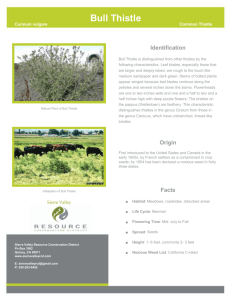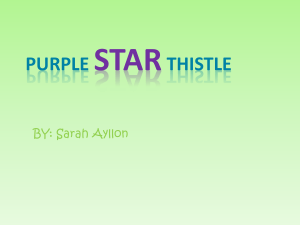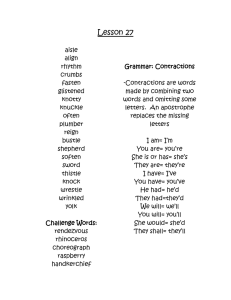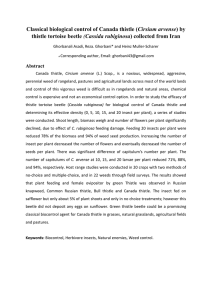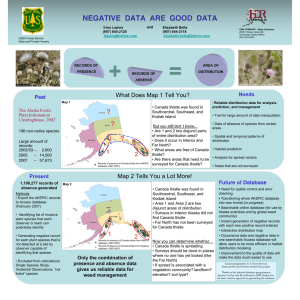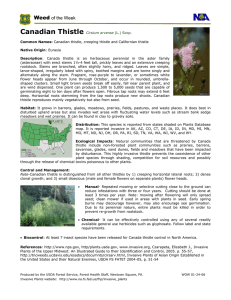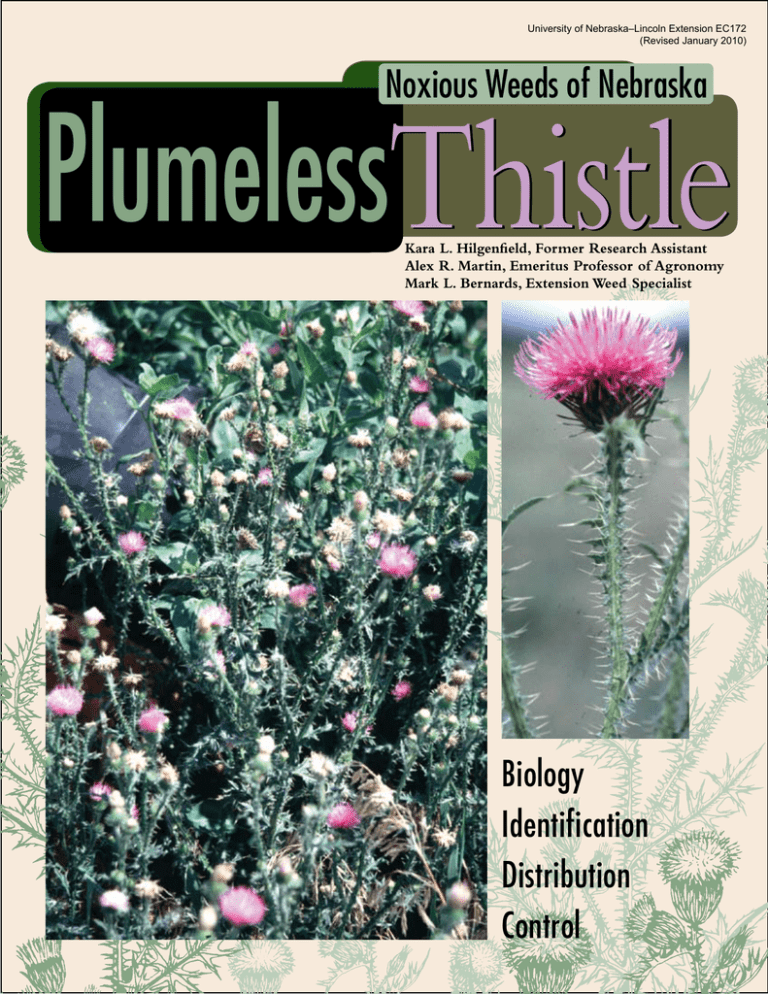
University of Nebraska–Lincoln Extension EC172
(Revised January 2010)
Noxious Weeds of Nebraska
PlumelessThistle
Kara L. Hilgenfield, Former Research Assistant
Alex R. Martin, Emeritus Professor of Agronomy
Mark L. Bernards, Extension Weed Specialist
Biology
Identification
Distribution
Control
Thistle
PlumelessThistle
P
lumeless thistle (Carduus acanthoides
L.) is an invasive broadleaf weed
native to Europe and Asia. Sometimes
referred to as spiny plumeless thistle, it
currently infests about 51,000 acres in
Nebraska, primarily in the northeast.
It is economically important because
it reduces the productivity of pastures
and rangeland by competing with and
suppressing the growth of desirable
species (Figure 1). Plumeless thistle
can colonize overgrazed pastures,
rangeland, and disturbed open sites,
e.g. roadsides, ditches, etc. Plumeless
thistle is similar in appearance, biology,
and ecology to its close relative, musk
thistle (Carduus nutans L.). Although
plumeless and musk thistle occupy
similar habitats, they are seldom found
in mixed populations. Because of
plumeless thistle’s status as a noxious
weed, landowners and producers in
Nebraska spend thousands of dollars
each year to control it.
Biology
P
lumeless thistle is a member of
the sunflower family (Asteracea). It
generally completes its lifecycle as a
biennial (Figure 11), but may grow as
a winter annual or rarely as a summer
Figure 1. Dense infestations of plumeless thistle interfere with livestock grazing and degrade the value of pastures or range.
History
T
1
he center of origin of plumeless thistle is believed to be southern Europe because of the large
number of Carduus species found there. The first record of plumeless thistle growing in North
America was at Camden, N.J., in 1879. In a 1974 survey, the most severe infestations were in
Virginia, Pennsylvania, Wisconsin, Minnesota, South Dakota, Nebraska, and Wyoming. Its present
distribution stretches from Virginia into Canada, west across the Great Lakes states, through the
Great Plains and into Idaho, Washington, and California. In 1967, the Nebraska Legislature declared
plumeless thistle a noxious weed, thereby requiring all landowners in the state to control it.
annual, depending on environmental
conditions. Biennials take two seasons to complete their life cycle, with
vegetative growth in the first year
and continued vegetative and then
reproductive growth in the second.
Plumeless thistle seeds begin germinating in April and can germinate
through the summer and early fall
as conditions allow (adequate moisture and open soil). The plant forms
a rosette (a circular cluster of leaves
growing close to the ground) the first
summer or fall and overwinters in the
rosette stage (Figure 2). The plant bolts
(forms a flowering stalk) in spring of
the second year. In Nebraska, plumeless thistle flowering begins in June
and continues into August.
Plumeless thistle reproduces by
seed. Approximately 50 to 80 seeds
are produced per head, and a typical
plant will produce 35 to 60 heads.
Although most seeds germinate the
following year, they can remain viable
in the soil for more than 10 years.
Most seeds are found in the top 3
inches. Because of its high seed production and seed longevity, it can
be a very persistent weed where it
becomes established.
Plumeless thistle is cross-pollinated
and relies on wind or pollinating
insects (bees and wasps) for pollination.
As a result, hybridization with musk
thistle can occur. The hybrid plants are
generally sterile and have flowers larger
than those of plumeless thistle, but
smaller than those of musk thistle.
Most plumeless thistle seeds fall
near the parent plant. The expansion
of a plumeless thistle patch depends
on the number of seeds produced
and the amount of open soil available
for new plants to colonize. In a study
conducted in Maryland, the spread
of new infestations from a single
plant was less than 3 feet per year.
The seeds are attached to a pappus, a
white feathery attachment that aids
wind dispersal, and occasionally may
be carried by the wind up to 330 feet
from the mother plant. In most cases,
however, the pappus breaks off and
blows away while the seed remains
attached to the flower head.
© 2009, The Board of Regents of the University of Nebraska on behalf of the University of Nebraska–Lincoln Extension. All rights reserved.
Plumeless thistle is a source of nectar
for many insect species. Songbirds eat
the thistle seeds and contribute to seed
dispersal. Livestock will usually avoid
eating plumeless thistle because of the
spines on its stems and leaf margins.
Identification
P
lumeless thistle is similar in appearance to musk thistle, particularly in
the rosette stage. Like musk thistle, it
is supported by a stout, fleshy taproot,
which can penetrate the soil to a depth
of several feet. Leaves of a plumeless thistle rosette are narrowly oval
or oblong (Figure 2) and are deeply
lobed (Figure 3). The underside of the
leaf (and occasionally the upperside) is
covered with hair (pubescence). Three
or four of the points of each lobe end
in a short spine. In contrast, the leaves
of musk thistle are not as deeply lobed
and lack hairs (Figure 4).
The stem leaves of the plumeless
thistle are alternate, similar in shape
to those of the rosette, have hair, and
are 4 to 8 inches long (Figure 3). The
leaves extend onto the stem, giving it a
winged appearance (see photos on the
front cover). Two other thistle species,
Scotch and musk, also have leaves that
extend onto the stem and form spiny
wings. However, musk thistle leaves
lack hair, and Scotch thistle leaves are
less deeply lobed and are covered by
matted, dense hairs that give it a
bluish- or grayish-green appearance.
Plumeless thistle may grow to a
height of 1 to 5 feet, but usually are 3
to 4 feet. The stem is erect and freely
branching, especially in the upper
Figure 2. Plumeless thistle rosette leaves are narrowly oval
or oblong and deeply lobed.
Figure 3. Stem leaves of plumeless thistle are lobed almost to
the midrib. Note the spines on the end points of each lobe and
the hairs on the underside of the leaf.
Figure 4. Leaves of musk thistle (left) and the more deeply
lobed leaves of plumeless thistle (right).
Figure 5. Plumeless thistle branches freely in the upper portion of the plant.
© The Board of Regents of the University of Nebraska–Lincoln. All rights reserved.
2
portion of the plant (Figure 5). The
stem can be densely hairy to nearly
hairless. A distinguishing characteristic
separating plumeless thistle from musk
thistle is the presence of spiny wings
on the flowering stalk (1/8 to 5/8 inch
wide) up to the base of the plumeless thistle head (Figure 6). Scotch thistle also has spiny wings to the base of
the thistle head.
The flower of plumeless thistle is
purple, or rarely white or yellow, and
is 1/2 to 3/4 inch long (Figure 6). The
flower heads are solitary or in clusters of
two to five. The heads are 5/8 to 1 inch
tall and 3/8 to 3/4 inch wide. There
are several series of bracts or small leaflike structures below the flower head,
including spiny outer bracts (1/4 to 1/2
inch) and spineless inner bracts (3/4
inch). Flower heads of plumeless thistle
are smaller than those of musk thistle.
In addition, plumeless thistle may have
multiple heads per stem and the heads
are erect, while musk thistle has only
one head per stem and it is often nodding (Figure 7). Scotch thistle flower
heads are erect like plumeless thistle, but
are larger (1 to 2 inches wide and 3/4
to 1 inch tall).
The seed of plumeless thistle is
called an “achene” and is strawcolored to light-brown (Figure 8). It is
1/8 inch long and slightly oblong to
egg-shaped. It is marked by 10 brown
ribs that extend the length of the
seed. At one end of the seed, there is a
ring of tiny barbed bristles where the
pappus was attached.
Control Methods
P
lumeless thistle is best managed
using a combination of cultural,
mechanical, chemical and biological
control methods. The primary management goal should be to limit seed
production.
Cultural
The most cost effective strategy
is to maintain healthy, competitive, desirable plants in pastures or
grasslands. Dense cover limits thistle
establishment, and plumeless thistle
seedlings do not compete well with
established forage grasses.
First, pastures should be fertilized appropriately. Either too much
or too little nitrogen can create
opportunities for invading weeds.
Second, grazing animals should be
carefully managed. Because plumeless thistle is unpalatable to livestock,
Figure 7. Plumeless thistle [left] and musk thistle (nodding) [right]. Plumeless thistle flower stems are winged, but musk thistles are
not. Plumeless thistle flowers are smaller than those of musk thistle.
1/8 inch
3
Figure 6. Plumeless thistle has spiny wings on the flower stalk
up to the base of the thistle head.
Figure 8. Seed is straw colored to light brown and 1/8 inch long.
© The Board of Regents of the University of Nebraska–Lincoln. All rights reserved.
Mechanical
Plumeless thistle does not tolerate regular cultivation, digging, or
cutting. Mowing at late bloom stage
effectively reduces seed production
(Figure 9). If mowing occurs before
the first terminal buds bloom, the
plants will regrow and produce viable
seed. Mowing after the terminal
buds have matured has little effect on
reducing the amount of seed in the
soil, even if there are still flowers on
the lateral buds. At stages before flowering, plumeless thistle must be cut at
the soil surface to prevent the crown
buds from resprouting.
reduce seed production. The numthey drift onto susceptible crops and
ber of herbicide labels that describe
trees like soybean, tomatoes, grapes,
use for plumeless thistle in the bud
pecans, and walnuts. Applying herbistage is limited (Chaparral, Cimarron,
cides in the fall can minimize the risk
ForeFront, Milestone, Telar). When
of injury from drift, especially if the
herbicides are ground-applied, use a
crops have matured or the leaves have
dropped. When herbicides are applied
minimum of 10 gallons per acre to
in the spring and sensitive species are
ensure adequate coverage.
nearby, avoid spraying on windy days.
Fall is an ideal time to apply herIn addition, select nozzles that will
bicides to control plumeless thistle.
provide the largest droplet size possible
Applications should be made at the
without reducing foliar coverage of the
seedling stage (rosettes of 4-10 leaves)
target plants.
while plants are actively growing
and daytime temperatures are above
It is important to scout pastures
50oF. In the fall, plumeless thistle is
prior to herbicide application to
in the seedling or rosette stage and is
determine if the infestation level
actively translocating sugars and other
justifies treatment over the whole
compounds from
100
the leaves to build
up root reserves.
Herbicides applied in
the fall move to the
roots with the translocating sugars and
this increases their
likelihood of killing
0
Seedling
Rosette
Bolting
Flowering
the plant.
Many of the herbiHerbicide
Growth Stage
Mowing
cides used to manage
plumeless thistle can
Figure 9. Response of plumeless thistle to herbicide application and mowing at
cause serious injury if
different growth stages.
% Control
they will preferentially graze the grass
around it and increase the competitive advantage of the thistle over the
grass. Overgrazing, especially when
soil moisture is limited and grasses
are stressed, may result in bare soil
and open niches for plumeless thistle
to spread. Third, periodic prescribed
burning can be an important tool for
maintaining vigorous grasses, but does
not generally kill thistle crowns and
has little effect on new seedling emergence. However, fire can reduce the
amount of viable seed laying on the
soil surface.
Unfortunately, even well-managed
grasslands are not exempt from potential infestations. Landowners and land
managers should regularly scout their
pastures to identify and treat small
patches of thistles before they become
dense infestations. Where infestations have previously been controlled,
repeated monitoring is necessary to
prevent the seeds that remain in the
soil from generating new patches.
Distribution
P
lumeless thistle infestations were reported in 31 Nebraska counties in 2006. The counties
with the most infested acres were in northeast Nebraska. Smaller infestations were identified
in southeast and central Nebraska and in the Panhandle. Plumeless thistle is seldom found in the
Sandhills and is primarily found in pastures, rangelands, and disturbed non-crop areas. It prefers
highly fertile soils that developed over limestone.
Chemical
Several herbicides are useful for
managing plumeless thistle infestations (Table 1). The timing of herbicide application is the key to success.
Plumeless thistle is most susceptible
to herbicides applied to plants in the
seedling or rosette stage. Delaying
herbicide application until bolting
or later reduces herbicide effectiveness. However, herbicide application
at late flower bud to early bloom can
Degree of Infestation
Heavy
Moderate
Light
None
Figure 10. Distribution of plumeless thistle in Nebraska in 2006. Plumeless thistle is found less extensively than either
Canada thistle or musk thistle.
© The Board of Regents of the University of Nebraska–Lincoln. All rights reserved.
4
Figure 11. Biennial life cycle of plumeless thistle in Nebraska.
Development of plants from seed
Spring
Emergence
from seed
Summer
Fall
Rosette
development
Winter
(Dormancy)
May
June
Bolt
Year 1
July
Flower
August
Death
Year 2
Apply herbicide
pasture, or if spot treatment of smaller
patches would be more appropriate.
Because plumeless thistle seeds
remain viable in the soil for up to 10
years, it is likely that once a stand is
established, treatments will need to
be repeated for several years until the
thistles are controlled and a good stand
of desirable grasses is re-established.
Biological
Introduced (exotic) plants often
lack the natural enemies (diseases or
insects) that check their spread in
native habitats. This increases their
ability to compete against native plants
and they become invasive when introduced into new habitats. Introducing
exotic diseases or insects for biological control of these exotic plants can
be risky, as the diseases or insects may
affect related, native plant species more
severely than the exotic plants.
Insects. Two exotic insects have
been released for biological control of plumeless and musk thistle.
Apply herbicide
The Rhinocyllus conicus head weevil,
an insect of European origin, has
been released in 23 states, including Nebraska. It lays eggs on bud
bracts and after hatching, the larvae
bore into receptacles and feed on the
receptacles and florets, reducing the
plant’s ability to produce seed. Its success at reducing seed set in plumeless
thistle has been limited because its
egg-laying period only coincides with
the formation of the terminal buds.
The lateral buds that emerge much
later are rarely affected.
A rosette-feeding beetle,
Trichosirocalus horridus, also introduced
from Europe, lays eggs on the lower
side of rosette leaves. When the larvae hatch, they feed on the rosette
crowns and can kill young rosettes.
Both of these exotic insects have been
established and have reduced plumeless thistle populations in Virginia. No
information is available on the success
of biocontrol agents in Nebraska.
Mow
Fungi. Four fungi are capable
of infecting musk and/or plumeless
thistle, including the rusts Puccinia
carduorum and P. galatica, and the smuts
Ustilago cardui and U. violacea. Of these,
only P. carduorum has been introduced
in North America.
Biological control agents should be
considered as tools in plumeless thistle
management; however, these practices
should not be relied on to eradicate
an infestation. The success of biological control agents depends on the
survival of enough individuals of the
invasive species (the thistle) to support the survival of the insect or plant
disease. As a result, biological control
may be most beneficial in remote
areas where chemical or mechanical
control methods are not practical.
Note: Reference to commercial products or
trade names is made with the understanding that no discrimination is intended and no
endorsement by University of Nebraska–Lincoln
Extension is implied.
5
© The Board of Regents of the University of Nebraska–Lincoln. All rights reserved.
Table 1.
Herbicide treatments for plumeless thistle control. Please refer to the section on chemical control for additional
information on herbicide timing and drift control.1,2
Herbicide
Active Ingredient
Product per Acre
Application Time
Notes
2,4-D ester (4L)
2,4-D
1.5-2.0 qt
Late fall or early spring
2,4-D ester (4L)
+ dicamba
2,4-D,
dicamba
1 qt + 0.5 pt
Late fall or early spring
Annual treatment may be necessary for control of new
seedlings. In the spring, apply before bolting for best result,
and prior to trees leafing out to reduce drift injury.
Chaparral
aminopyralid,
metsulfuron
1.0-2.0 oz
Rosette to early bolt
Cimarron Max
metsulfuron,
dicamba,
2,4-D
0.5 oz Part A, Rosette to early bolt
2 pt Part B
Add a non-ionic surfactant (0.25-0.5% v/v), a crop oil
concentrate, (1-2% v/v) or a methylated seed oil (0.5%
v/v). Also add 2-4 qt/ac urea ammonium nitrate3 (28%
N). For use in pasture and range.
Cimarron Plus
metsulfuron,
chlorsulfuron
0.63 oz
Rosette to early bolt
Cimmaron X-tra metsulfuron,
chlorsulfuron
1.0 oz
Rosette to early bolt
Add a non-ionic surfactant (0.25-0.5% v/v), a crop oil
concentrate or methylated seed oil (1-2% v/v). Also add
2-4 qt/ac urea ammonium nitrate3 (28% N). For use in
pasture and range.
Curtail
clopyralid,
2,4-D
2-4 pt
Rosette to early bolt
Use lower rate for wheat or grasses sensitive to 2,4-D. For
use in wheat, fallow, range, pasture, and non-crop areas.
ForeFront
aminopyralid,
2,4-D
1.5-2.0 pt
Rosette to early bolt
Apply as a coarse, low pressure spray. Add a non-ionic surfactant (0.25-0.5% v/v) for improved coverage. For use in
pasture and range.
Grazon P+D
picloram,
2,4-D
2-4 pt
Rosette to early bolt
Use higher rate for bolting plants. A nonionic surfactant
may be added to improve coverage. For use on range and
permanent pasture.
Milestone
aminopyralid
3-5 fl oz
Rosette to early bolt
Use higher rate for bolting plants. Add a non-ionic surfactant (0.25-0.5% v/v) for improved coverage. For use on
range, permanent pasture and non-crop areas.
Overdrive
diflufenzopyr
+ dicamba
4 fl oz
Late fall or early spring
Apply before bolting. Add a non-ionic surfactant (0.25%
v/v). For use on range, permanent pasture, and non-crop
areas.
Redeem R&P
triclopyr +
clopyralid
1-2 pt
Rosette to early bolt
Use higher rate for bolting plants. Add a non-ionic surfactant (0.25-0.5% v/v). For use on range, permanent pasture,
and non-crop areas.
Telar
chlorsulfuron
1 oz
Bolted plant prior to
flowering
Add a non-ionic surfactant at 0.25% (v/v). For use in
range, pasture, and non-crop areas.
Tordon 22K
picloram
8-12 fl oz
Late fall
Annual treatments may be necessary. For use on range,
permanent pasture, and non-crop areas.
Transline
clopyralid
0.33-1.0 pt
Rosette to early bolt
Use higher rates for bolting plants. Add a nonionic surfactant (0.25-0.5% v/v). For use on range, permanent pasture,
and non-crop areas.
Apply as a coarse, low pressure spray. Add a non-ionic surfactant (0.25-0.5% v/v) for improved coverage. Increase
rate to 2.5 oz and add 1 pt of 2,4-D when plants reach late
bolt to early flowering. For use in pasture and range.
1
These recommendations were current as of September 1, 2009. For current information, see the Guide for Weed Management in Nebraska, EC-130, available in
print at University of Nebraska-Lincoln Extension offices or on the Web at http://www.ianr.unl.edu/pubs/fieldcrops/EC130.htm
2
References to commercial products is made with the understanding that no discrimination is intended and no endorsement by University of Nebraska-Lincoln
Extension is implied.
Spray grade ammonium sulfate (AMS) may be substituted for urea ammonium nitrate at 2-4 lb/ac.
3
6
© The Board of Regents of the University of Nebraska–Lincoln. All rights reserved.
References
Allen, M.R. and K. Shea. 2006. Spatial segregation of congeneric
invaders in central Pennsylvania, USA. Biological Invasions 8:509521.
Batra, S.W.T., J.R. Coulson, P.H. Dunn, and P.E. Boldt. 1981. Insects
and fungi associated with Carduus thistles (Compositae). USDA
Technical Bulletin 1616. 100 pp.
Burnside, O.C., C.R. Fenster, L.O. Evetts, and R.F. Mumm. 1981.
Germination of exhumed weed seed in Nebraska, USA. Weed
Science 29:577-586.
Desrochers, A.M., J.F. Bain, and S.I. Warwick. 1988. The biology of
Canadian weeds. 89. Carduus nutans L. and Carduus acanthoides L.
Canadian Journal of Plant Science 68:1053-1068.
Dunn, P.H. 1976. Distribution of Carduus nutans, C. acanthoides, C.
pycnocephalus, and C. crispus in the United States. Weed Science
24:518-524.
Feldman, I., M.K. McCarty, and C.J. Scifres. 1968. Ecological and
control studies of musk thistle. Weed Science 16:1-4.
Furrer, J.D. and M.K. McCarty. 1966. Musk thistle — Appearance,
spread and control. Nebraska Agriculture Experimental Station
Research Bulletin EC66-160.
Gassmann, A. and L.T. Kok. 2002. Musk thistle. In Van Driesche, R.,
et al. Biological control of invasive plants in the eastern United
States. USDA Forest Service Publication FHTET-2002-04.
Harris, P. 1984. Carduus nutans L., nodding thistle and C. acanthoides
L., plumeless thistle (Compositae). Pages 115-116 in J. S. Kelleher
and M. A. Hulme, eds. Biological control programs against insects
and weeds in Canada, 1969-1980.
Hull, A.C. and J.O. Evans. 1973. Musk thistle (Carduus nutans): an
undesirable range plant. Journal of Range Management 26:383385.
Center for Invasive Specimens and Ecosystem Health. 2008. Spiny
plumeless thistle. http://www.invasive.org/
Jongejans, E., O. Skarpaas, P.W. Tipping, and K. Shea. 2007.
Establishment and spread of founding populations of an invasive
thistle: the role of competition and seed limitation. Biological
Invasions 9:317-325.
Kok, L.T. 1986. Impact of Trichosirocalus horridus (Coleoptera:
Curculionidae) on Carduus thistles in pastures. Crop Protection
5:214-217.
Kok, L.T., and A. Gassmann. 2002. Plumeless thistle. In Van Driesche,
R., et al. Biological control of invasive plants in the eastern United
States. USDA Forest Service Publication FHTET-2002-04.
Laterra, P., E.Z. Ortega, M. Del Carmen Ochoa, O.R.Vignolio, O.N.
Fernandez. 2006. Interactive influence of fire intensity and vertical
distribution of seed banks on post-fire recolonization of a talltussock grassland in Argentina. Austral Ecology 31:608-622.
Louda, S.M., R.W. Pemberton, M.T. Johnson and P.A. Follett. 2003.
Nontarget effects — The Achilles’ Heel of biological control?
Retrospective analyses to reduce risk associated with biocontrol
introductions. Annual Review of Entomology 48: 365-396.
McCarty, M.K. and C.J. Scifres. 1969. Life cycle studies of the
musk thistle. Nebraska Agricultural Experiment Station Research
Bulletin No. 230.
McCarty, M.K., C.J. Scifres, A.L. Smith, and G.L. Horst. 1969.
Germination and early seedling development of musk and plumeless thistle. Nebraska Agricultural Experiment Station Research
Bulletin No. 229.
McCarty, M.K., C.J. Scifres, and L.R. Robison. 1973. A descriptive guide for major Nebraska thistles. Nebraska Agricultural
Experiment Station SB493.
McCarty, M.K. and J.L. Hatting. 1975. Effects of herbicides or mowing on musk thistle seed production. Weed Research 15:363-367.
Roberts, H.A. and R.J. Chancellor. 1979. Periodicity of seedling
emergence and achene survival in some species of Carduus, Cirsium,
and Onopordum. Journal of Applied Ecology 16:641-548.
Smith, L.M. and L.T. Kok. 1984. Dispersal of musk thistle Carduus
nutans seeds. Weed Science 32:120-125.
Smyth, A. and J.L. Hamrick. 1987. Realized gene flow via pollen in
artificial population of musk thistle Carduus nutans L. Evolution
41:613-619.
Stubbendieck, J., M.J. Coffin, and L.M. Landholt. 2003. Weeds of
the Great Plains. 3rd edition. Nebraska Department of Agriculture,
Lincoln, Nebraska.
Tipping, P.W. 2008. Mowing-induced changes in soil seed banks
and populations of plumeless thistle (Carduus acanthoides) and musk
thistle (Carduus nutans). Weed Technolology 22:49-55.
USDA. 2009. Plants Profile — Carduus acanthoides. http://plants.usda.
gov.
USGS. 2006. An assessment of exotic plant species of Rocky
Mountain National Park — Carduus nutans L. http://www.npwrc.
usgs.gov/resource/plants/explant/cardnuta.htm.
A Message From the Nebraska Department of Agriculture
7
The State of Nebraska has had a noxious
weed law for many years. Over the years, the
Nebraska Legislature has revised this law.
The term “noxious” means to be harmful
or destructive. In its current usage “noxious”
is a legal term used to denote a destructive or
harmful pest for purposes of regulation. When a
specific pest (in this case, a weed) is determined
to pose a serious threat to the economic, social,
or aesthetic well-being of the residents of the
state, it may be declared noxious.
Noxious weeds compete with crops,
rangeland, and pastures, reducing yields substantially. Some noxious weeds are directly
poisonous or injurious to man, livestock, and
wildlife. The losses from noxious weed infestations can be staggering, costing residents
millions of dollars due to lost production.
This not only directly affects the landowner,
but erodes the tax base for all residents of the
state. The control of noxious weeds is
everyone’s concern and their control is to
everyone’s benefit. The support of all individuals within the state is needed and vital
for the control of noxious weeds within
Nebraska.
It is the duty of each person who owns
or controls land in Nebraska to effectively
control noxious weeds on their land. County
boards or control authorities are responsible
for administration of noxious weed control
laws at the county level. This system provides
the citizens of Nebraska with “local control.” Each county is required to implement
a coordinated noxious weed program. When
landowners fail to control noxious weeds on
their property, the county can serve them with
a notice to comply. This notice gives specific
instructions and methods on when and how
certain noxious weeds are to be controlled.
The Director of Agriculture determines
which plants are to be deemed as “noxious”
and the control measures to be used in preventing their spread. In Nebraska, the following weeds have been designated as noxious:
Canada thistle (Cirsium arvense (L.) Scop.)
Leafy spurge (Euphorbia esula L.)
Musk thistle (Carduus nutans L.)
Plumeless thistle (Carduus acanthoides L.)
Purple loosestrife (Lythrum salicaria L. and
L. virgatum - including any cultivars and
hybrids)
Knapweed (spotted and diffuse) (Centaurea
maculosa Lam. and C. diffusa Lam.)
Common Reed (Phragmites sp.)
Salt Cedar (Tamarix ramosissima Ledeb.)
Whether farmer or rancher, landowner or
landscaper, it’s everyone’s responsibility and
everyone’s benefit to aid in controlling these
noxious weeds. If you have questions or concerns regarding noxious weeds in Nebraska,
please contact your local county noxious weed
control authority or the Nebraska Department
of Agriculture.
© The Board of Regents of the University of Nebraska–Lincoln. All rights reserved.
Illustration of the plumeless thisle is by Bellamy Parks Jansen; originally published
in Weeds of Nebraska and the Great Plains. Used with permission of the publisher,
the Nebraska Department of Agriculture.
Plumeless
Thistle
Published by University of Nebraska–Lincoln Extension in cooperation with
and with financial support from the Nebraska Department of Agriculture.
Extension is a Division of the Institute of Agriculture and Natural Resources at the University of Nebraska–Lincoln
cooperating with the Counties and the United States Department of Agriculture.
University of Nebraska–Lincoln Extension educational programs abide with the nondiscrimination policies
of the University of Nebraska–Lincoln and the United States Department of Agriculture.

